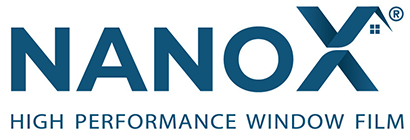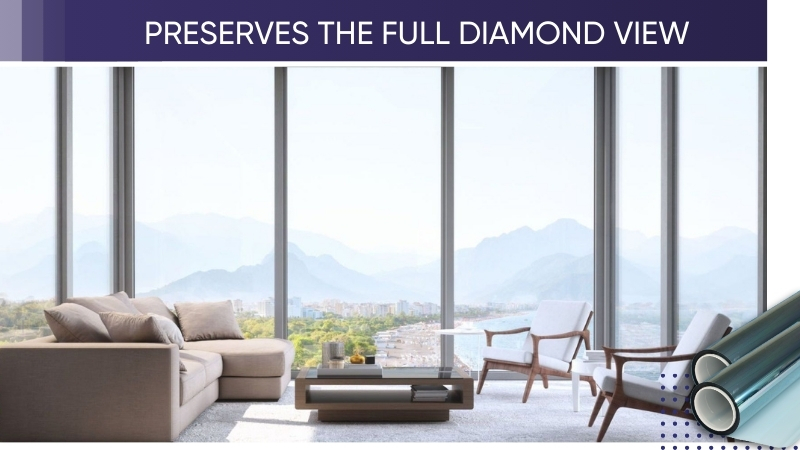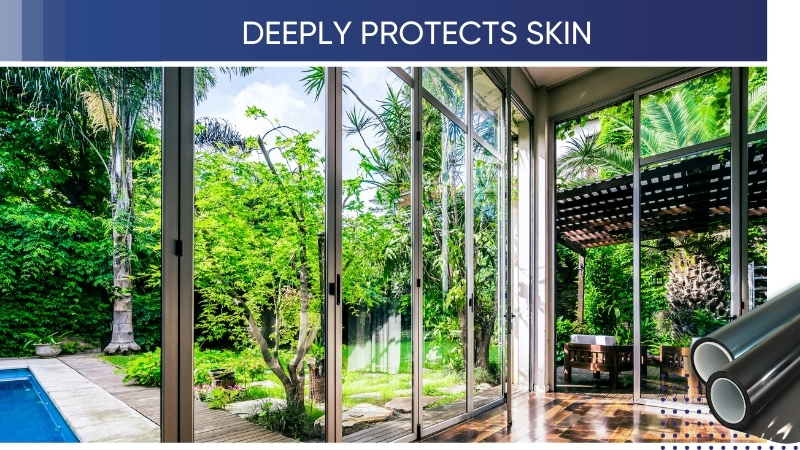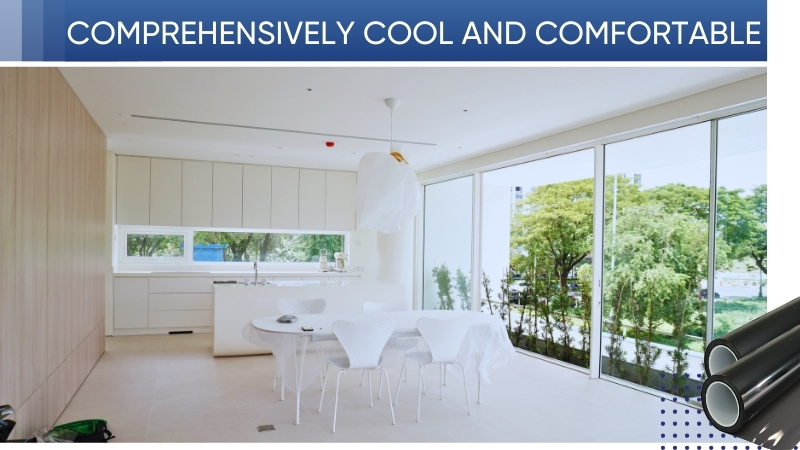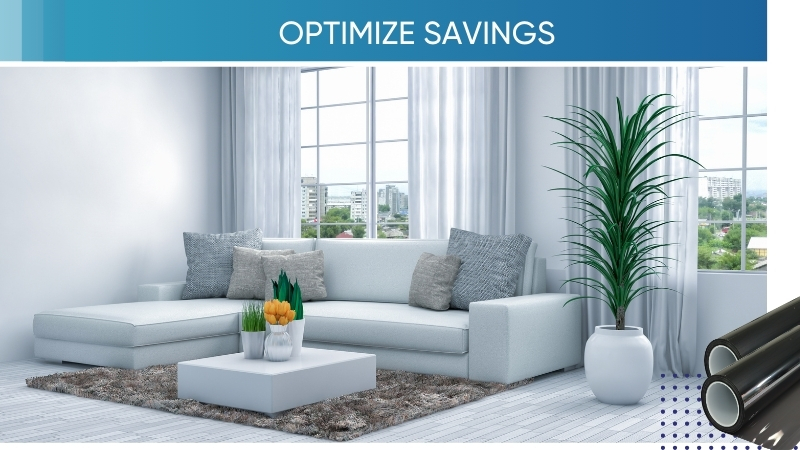Window Insulation Film is considered one of the most modern, effective, and simple solutions for preventing heat through windows and glass doors in residential spaces today. The main function of the film is to block heat from sunlight outside from entering inside.
This type of film is usually made from Polyethylene Terephthalate (PET) combined with spectral filtering technologies. This creates a film capable of heat rejection and sun protection. Insulation film has two main types: window insulation film and automotive insulation film.
NanoX Window Insulation Film Price List
NanoX Window Insulation Film Price List (effective from 1/1/2025):
| Product | Film Color |
Unit Price (VND/m²)
|
| Diamond View Series | ||
| NanoX P70 Insulation Film | Transparent with ocean blue tint | 990.000 |
| NanoX D80 Insulation Film | Transparent light gray | 790.000 |
| UV400 Skincare Series | ||
| NanoX U70 Insulation Film | Transparent with green tint | 790.000 |
| NanoX B30s Insulation Film | Light gray | 790.000 |
| NanoX B15s Insulation Film | Dark gray | 790.000 |
| Ice-Con Series | ||
| NanoX B60 Insulation Film | Transparent gray | 550.000 |
| NanoX B30 Insulation Film | Light brown tea | 550.000 |
| NanoX B15 Insulation Film | Dark brown tea | 550.000 |
| Eco-Cool Series | ||
| NanoX A75 Insulation Film | Transparent with ocean blue tint | 400.000 |
| NanoX A30 Insulation Film | Light gray | 400.000 |
| NanoX A20 Insulation Film | Dark gray | 400.000 |
| NanoX A5 Insulation Film | Black | 400.000 |
| Reflective Series | ||
| NanoX VB15 Insulation Film | Reflective ocean blue | 400.000 |
| NanoX VG15 Insulation Film | Reflective green | 400.000 |
| Glass Protection Series | ||
| NanoX SF 4 MIL Insulation Film | Transparent, colorless | 300.000 |
- The price list for NanoX window insulation film ranges from 300.000 to 990.000 VND/m².
- The above prices include full installation.
- Film size: 1.52 m x 30 m
NanoX Window Insulation Film Technical Specifications
Diamond View Series
NanoX Diamond View focuses on high heat rejection while maintaining a clear view. This is the perfect choice for living spaces with a “million-dollar view.”
- High heat rejection
- 100% infrared ray blocking
- High light transmission – Ultra-clear, unobstructed view
- Health protection
- Interior protection
- Specification Table
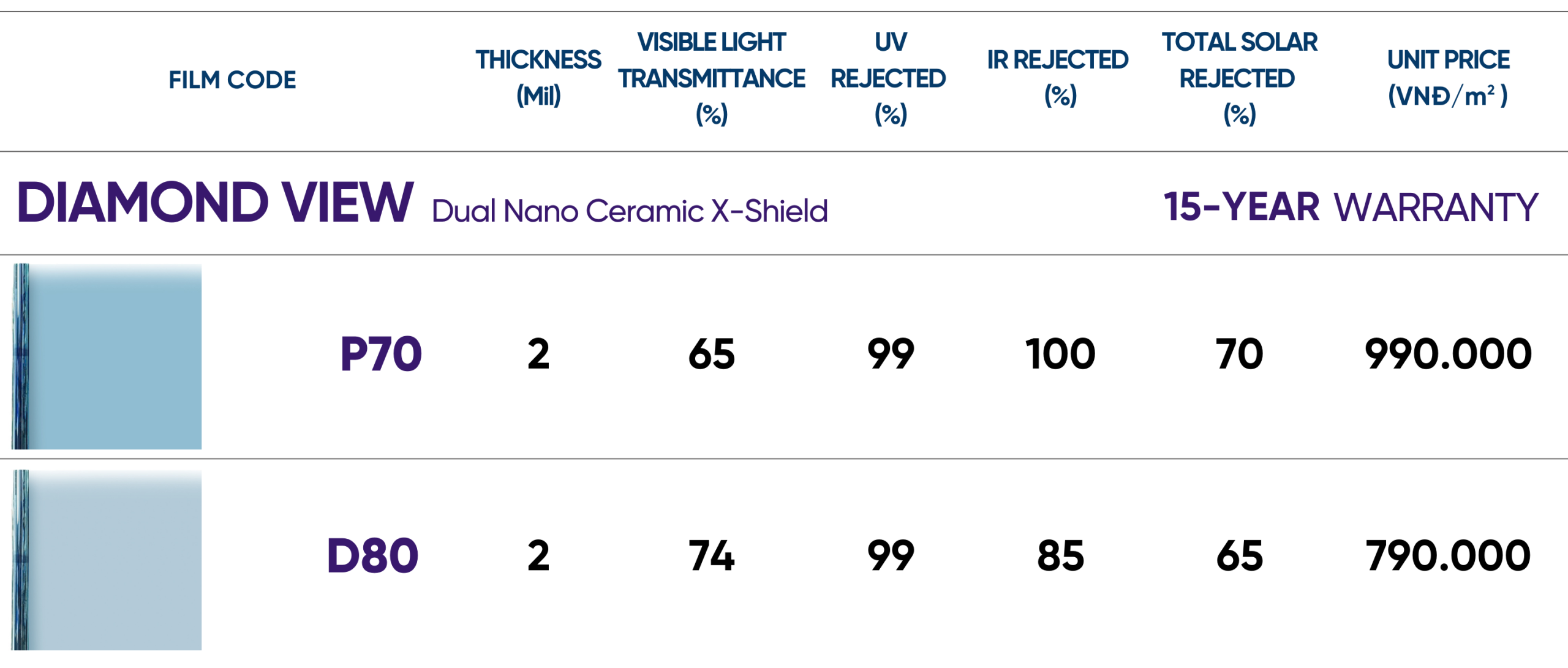
UV400 Skincare Series
NanoX UV400 Skincare combines both high heat rejection and advanced skin protection with a broad-spectrum UV filtering system.
- High heat rejection
- 100% UV400 blocking – Advanced skin protection
- Interior protection
- Enhanced privacy
- Improved glass safety
- Specification Table

Ice-Con Series
NanoX Ice-Con fully meets requirements for heat insulation, UV protection, privacy enhancement, and affordability.
- Up to 90% heat rejection
- 99% UV blocking
- Interior protection
- Enhanced privacy
- Improved glass safety
- Specification Table
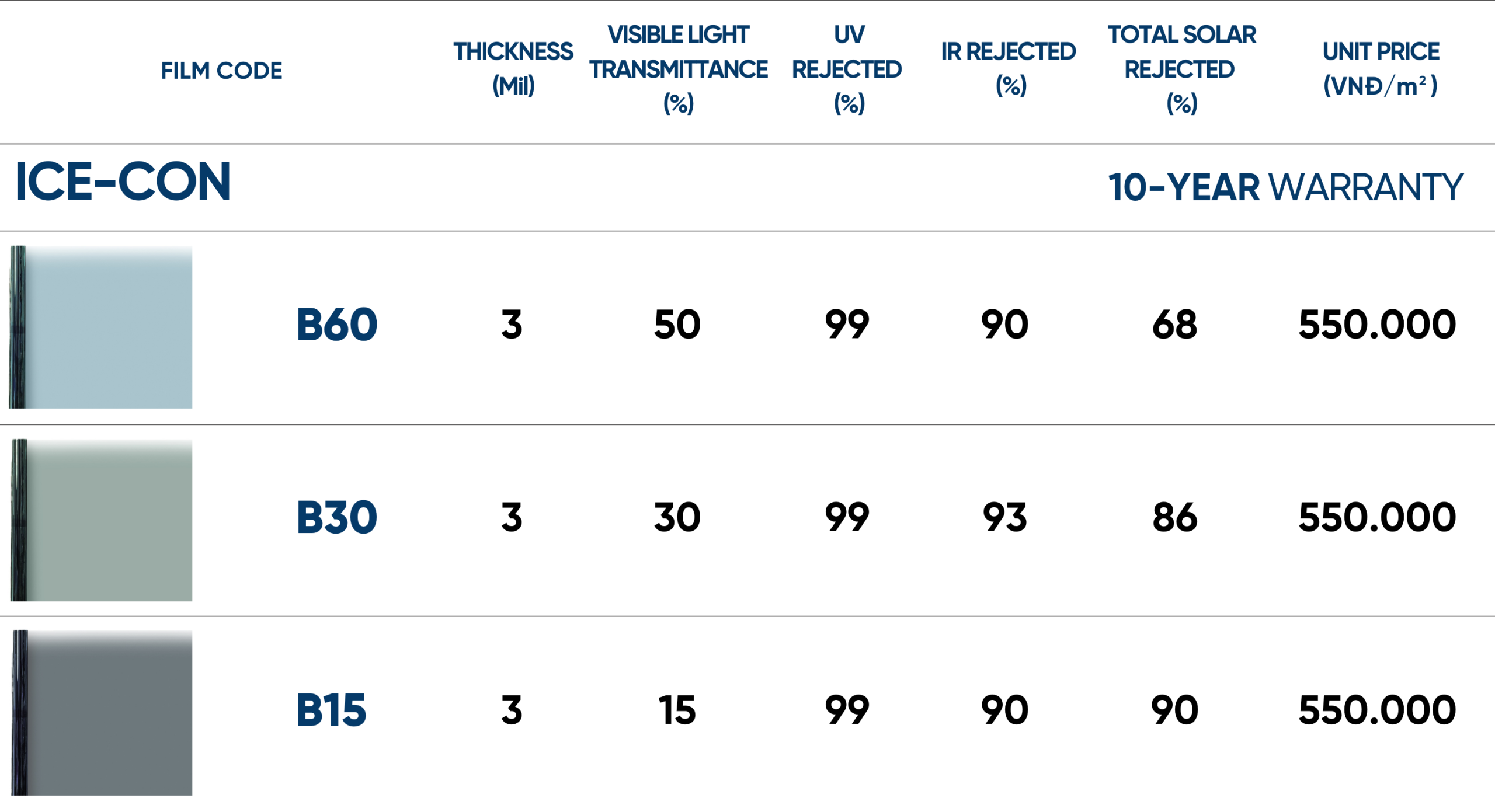
Eco-Cool Series
NanoX Eco-Cool is an economical choice for effective heat reduction and energy savings.
- Good heat rejection
- 99% UV blocking
- Interior protection
- Enhanced privacy
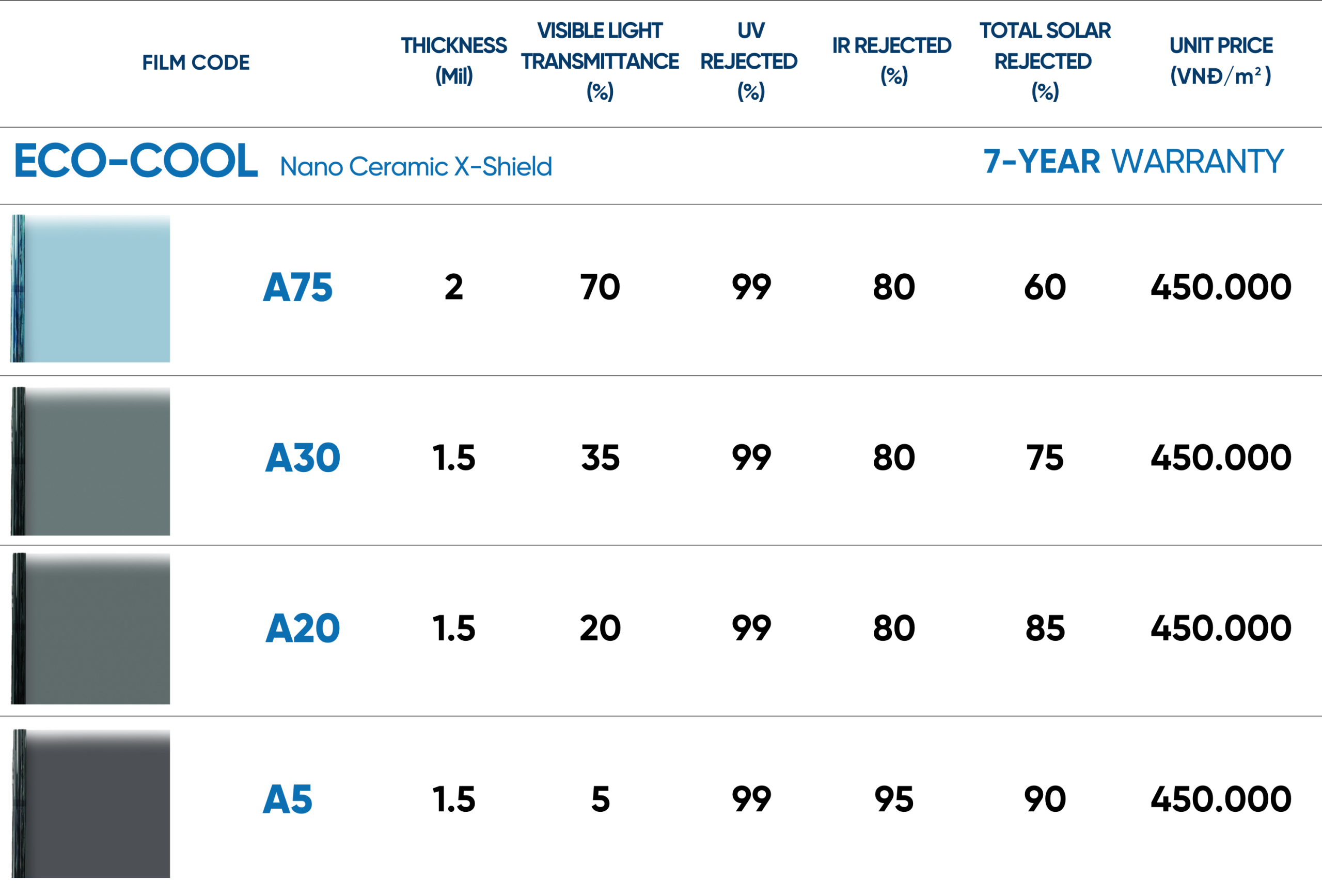
Should You Apply Insulation Film to Residential Glass Windows?
While popular worldwide, window insulation film is still relatively new in Vietnam—leading many to ask: Is it truly effective?
Among heat-reducing solutions for homes, insulation film is modern, efficient, and easy to apply. It significantly lowers heat transfer through glass, with proven results users can feel immediately. Beyond heat control, it also enhances comfort, saves energy, protects interiors, and improves privacy.
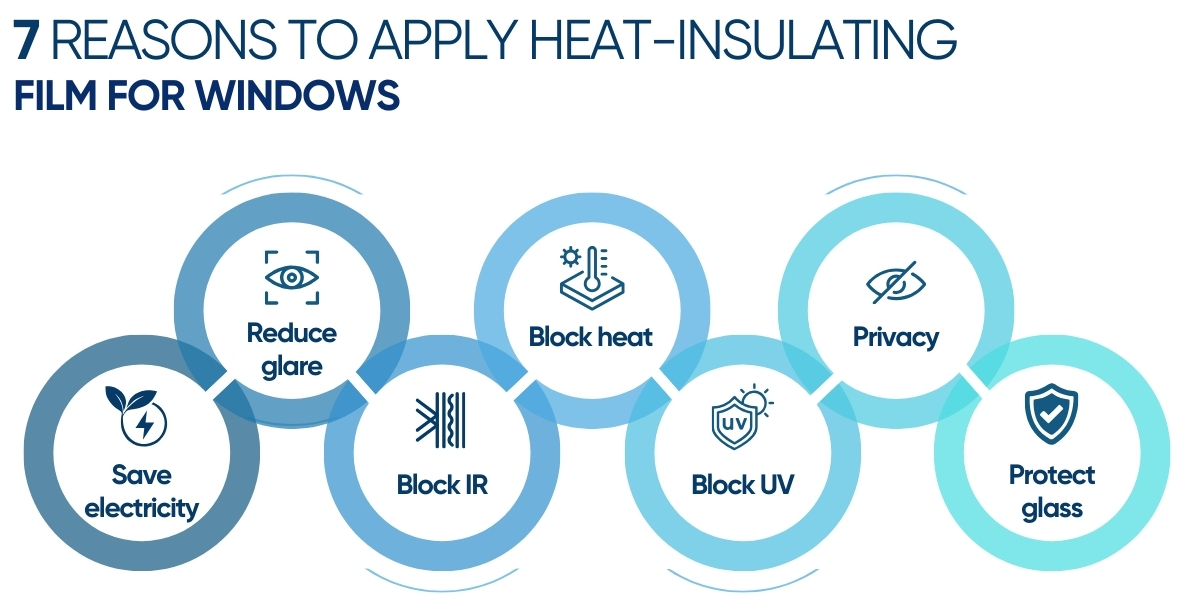
Key Benefits of Window Insulation Film
- Heat Rejection & Cooling Effect: Insulation film works by absorbing and reflecting heat, preventing solar heat from penetrating indoors. This helps maintain a cooler and more comfortable home environment.
- Infrared Radiation (IR) Blocking: IR radiation is the main cause of heat from sunlight. Premium window insulation films can filter infrared rays, maximizing overall heat rejection.
- Ultraviolet (UV) Protection: UV radiation not only causes skin damage and health issues but also fades interior furnishings. High-quality insulation films can block 99–100% of UV rays, ensuring protection for both people and property.
- Glare Reduction: Insulation film helps regulate light, reducing glare from direct sunlight and enhancing indoor comfort.
- Energy Savings: By maintaining a stable indoor temperature, window insulation film reduces the workload on air conditioning systems, leading to optimal energy savings.
- Enhanced Privacy: By utilizing the difference in light levels between indoor and outdoor environments, insulation film can limit visibility from the outside, increasing privacy and security.
- Glass Safety Reinforcement: Insulation film can also act as a protective layer, strengthening glass and minimizing risks in case of breakage or shattering.
Meaning of Window Insulation Film Technical Specifications
The technical specifications of window insulation film indicate its ability to block heat, infrared (IR) rays, ultraviolet (UV) rays, light transmission, reflectivity, and other properties.
- Total Solar Energy Rejected (TSER) – Heat Rejection: Indicates the film’s ability to reduce heat passing through the glass.
- Infrared Rejection (IR): Shows the film’s capability to block infrared rays from passing through the glass. IR rays are the primary source of heat in sunlight.
- Ultraviolet Rejection (UV): Represents the film’s effectiveness in blocking UV rays, which can cause skin damage, eye problems, and other health issues.
- Visible Light Reflectance (VLR) – Reflectivity: Indicates the level of reflectivity or mirror effect of the film.
- Visible Light Transmission (VLT) – Light Transmission: Measures how much light passes through the film, determining its brightness or darkness.
Experience in Installing Window Insulation Film
When applying insulation film to glass doors and windows, it is necessary to consider the following factors to choose a high-quality product.
Choosing by Manufacturing Technology
Window insulation films are classified into five main production technologies:
- Dyed Tint Film
- Metalized Tint Film
- Sputter Tint Film (Multi-layer Metal Sputtering)
- Nano Ceramic Tint Film
- Hybrid Tint Film
Which type of window insulation film is the best today?
Among the available options, ceramic films (Nano Ceramic) and multi-layer sputtered metal films (Sputter) are the most popular. However, sputtered films have the disadvantage of being expensive, making them less accessible to some customers. Ceramic films, on the other hand, offer good heat insulation, effective heat resistance, and a long lifespan, while being reasonably priced, making them a more popular choice.
Choosing based on building function
Window insulation films can be used for apartment glass, residential glass, townhouses, villas, offices, restaurants, hotels, shops, cafes, etc. However, depending on the function of each building, there will be specific types of window insulation films.
Currently, the market typically separates two main groups: residential glass films and office glass films. For office films, most projects use large volumes, so cost, particularly price, is a priority. In contrast, residential films focus on enhancing the user experience. Specifically, in addition to heat insulation, they often require many additional features such as UV protection, high transparency without affecting the view, and increased privacy.
Within each group, there are various types that meet different requirements. For example, within the office window sun protection film group, films for stores or shopping centers need to be clear so that people outside can easily see the products displayed inside. Meanwhile, films for restaurants, cafes, etc., will focus on sun protection and glare reduction.
Therefore, depending on the specific function of each building, it is necessary to choose the appropriate type of film. Even when prioritizing heat resistance, the chosen window sun protection film should not negatively impact the activities and experiences within the building.
Choosing based on window location
The window location is one of the top factors to consider when applying window film, as it affects the effectiveness of use. Residential windows have many different functions and locations such as glass windows/glass walls, entrance glass doors, skylight glass roofs (glass domes), outdoor glass roofs/balconies, etc.
For example, even within apartment windows, living room windows often need more natural light, while bedroom windows prioritize privacy. Therefore, heat-insulating films for living room windows should allow more light to pass through to both illuminate and maintain the view. For bedrooms, heat-resistant films combined with anti-peeping features are preferred.
Choosing based on sunlight direction
The direction of sunlight directly affects the amount of heat that enters the house through the windows. Specifically, the East receives early morning sun, with temperatures rising quickly but also dropping quickly. Conversely, the West receives strong afternoon sun, absorbing the most heat and keeping the house hot for longer, extending into the evening. The South receives consistent sunlight throughout the year but is not too intense. The North is the least affected by hot sunlight.
Therefore, when applying heat-resistant films to residential windows, it is necessary to consider the direction of sunlight on the windows. For example, if you want to protect a west-facing house from heat, you should choose a window insulation film with high total solar energy rejection (TSER) and anti-glare properties. This is because glass exposed to direct sunlight from the west tends to absorb a lot of heat and cause glare.
Choosing based on technical specifications
Window insulation films primarily function to protect against heat. Additionally, they offer many other features such as infrared (IR) rejection, ultraviolet (UV) rejection, high light transmission & transparency to maintain the view, anti-peeping, glass protection, etc. Corresponding to these features, there are specialized product lines, all of which are clearly indicated in the film’s technical specifications. Therefore, an important tip for applying heat-insulating film is to choose a film with specifications that closely match your actual usage needs.
For example, when you need to apply window film but still maintain the view and avoid changing the color of the glass, you should choose window films with high light transmission, transparency, and infrared rejection. If you prioritize health protection and the protection of interior furniture and equipment, films that block 100% UV rays are the best choice.
If you want to combine sun protection, anti-glare, and anti-peeping features, you can prioritize films with low light transmission, dark colors, black colors, or high reflectivity. If you also want to combine heat resistance and glass protection, choose the thickest film possible, ideally 2 mil or more.
Choosing based on color
Window insulation films come in many different colors. The most popular colors include brown tea, gray, black, blue, green, etc. You can choose the film color based on the interior and exterior space or the homeowner’s preference.
For example, if the interior is white-gray, you should choose a gray film. If you like a cool and comfortable feeling, you can choose a blue film. If you prioritize privacy, you can choose black window insulation films.
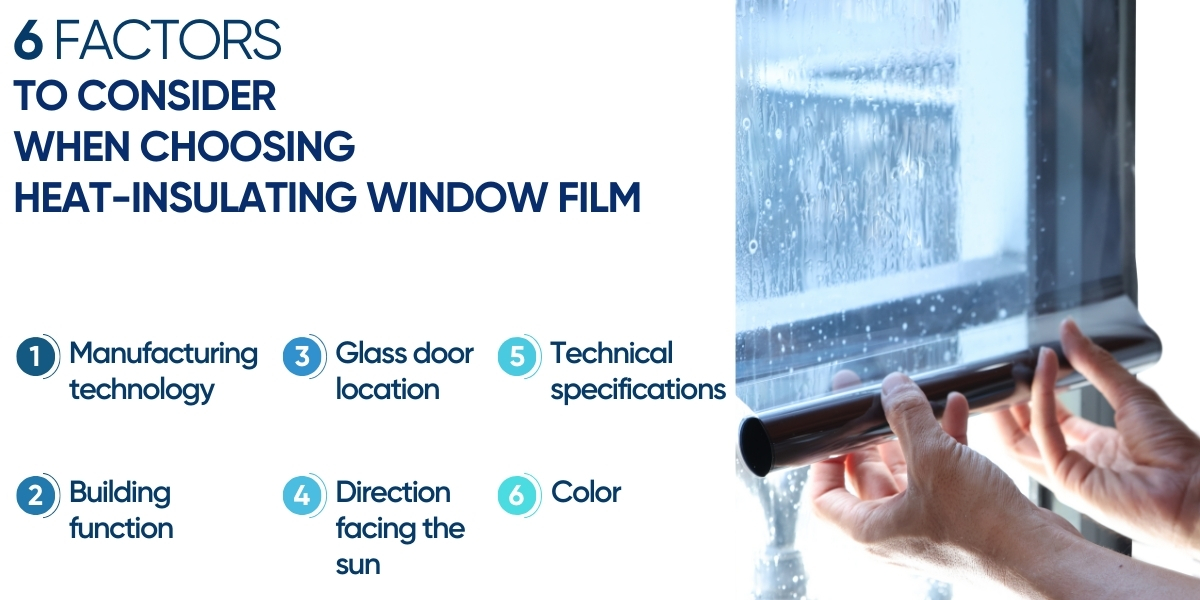
How to Check the Quality of Window Insulation Film
There are many ways to check, identify, and distinguish between high-quality and low-quality window insulation films.
- Check technical specifications: The technical specifications of the film can be checked using specialized industry measuring tools and equipment.
- Check heat rejection: The actual heat insulation effectiveness of the film can be tested using infrared lamps, demo application, and direct measurement with a thermometer.
- Check transparency: The higher the quality of the window insulation film, the higher its transparency. Therefore, it is necessary to carefully check the transparency of the film, avoiding choosing blurry, hazy, or glaring films that affect visibility.
- Check brand logo: Most genuine window insulation films have the brand logo and product code printed on them.
- Check in reality: Carefully observe the current condition. A high-quality insulation film will not have scratches, ripples, uneven colors, or peeling adhesive.
- Check warranty policy: Reputable insulation film brands have clear warranty policies and provide a warranty card after purchase. Some brands even offer electronic warranties.
- Check the reputation of the brand/distributor: It is advisable to choose window insulation films from reputable brands and official distributors with transparent information.
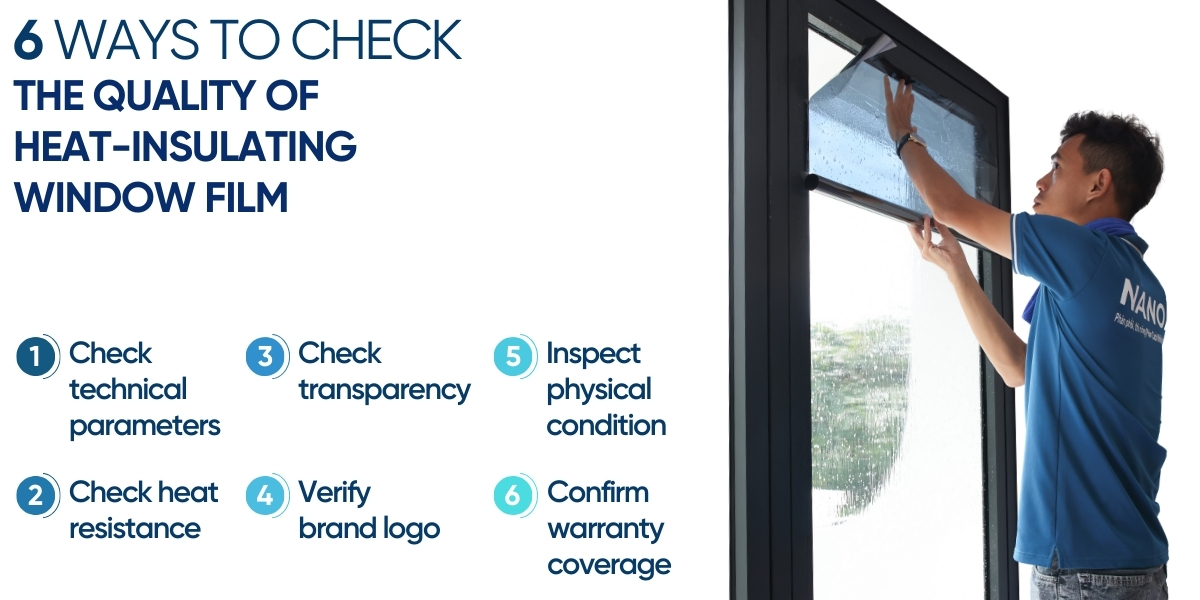
Should You Apply Window Insulation Film by Yourself at Home?
Applying sun-blocking window film requires full preparation of tools, especially specialized film application squeegees. In particular, besides mastering the method of applying window insulation film, the installer must also have a certain level of experience to achieve durability and high aesthetics. If applied incorrectly, the film is very prone to defects such as air bubbles, dust, wrinkles, and misalignment.
The current price lists for window insulation film usually include installation costs. Therefore, the ideal option is still to choose a full-service window insulation film application. Using this service ensures professional consultation & installation as well as long-term warranty in case of defects.
How to Apply Window Insulation Film
Steps to apply window insulation film:
- Step 1: Measure the window size
- Step 2: Cut the film according to the measured size
- Step 3: Prepare before applying
- Step 4: Clean the glass
- Step 5: Lay the film onto the glass surface
- Step 6: Squeegee out water and secure the film
- Step 7: Trim excess film
- Step 8: Inspect and clean up
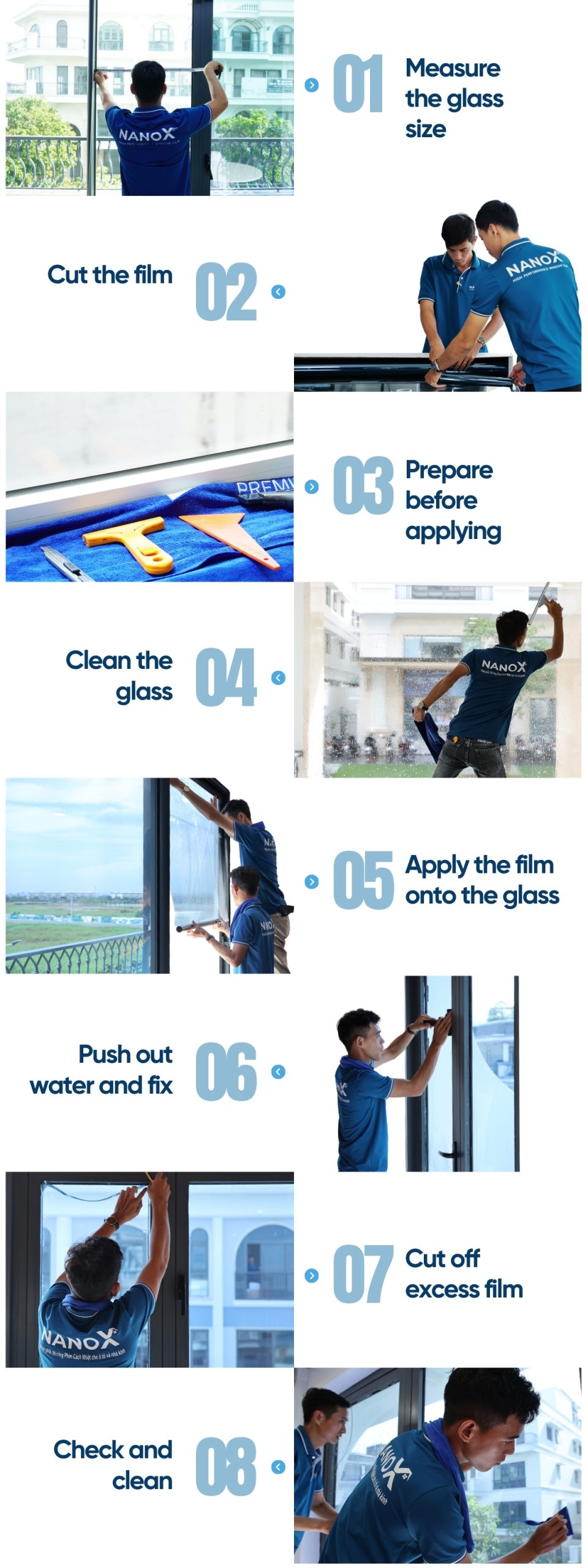
Notes after applying window insulation film
After applying heat insulation film to windows or glass doors, please note the following points to maintain the lifespan and effectiveness of the film:
Within 24 hours after applying the film: Do not touch, press firmly, or clean the film surface, as this may cause displacement since the adhesive layer has not fully dried yet.
During usage:
Avoid using strong chemical cleaning solutions to clean the glass surface. It is recommended to use a soft, damp cloth to gently wipe the film surface.
Do not use sharp objects to press or rub the film surface; avoid placing high-temperature objects (such as lighters) close to the film surface…

Introduction to NANOX HEAT INSULATION FILM
NanoX is a brand of heat insulation film for buildings and automobiles, developed in Vietnam by NanoFilm Trading and Services Company Limited in cooperation with Korea. Possessing advanced Nano Ceramic X-Shield technology, NanoX proudly offers powerful heat-blocking films, providing absolute protection against harmful rays, ultra transparency, and long-lasting durability… A special point is that this technological platform has been improved and optimized to deliver high-quality products to customers at the best possible price.
NanoX Products & Services
NanoX window and glass insulation films are specifically developed for architectural projects using tempered glass, such as:
- Residential: Townhouses, villas, apartments, condominiums…
- Offices: Offices, factories, workshops, laboratories…
- Commercial establishments: Restaurants, hotels, cafes, shops, showrooms, shopping centers…
- Public buildings: Schools, ports, stations, hospitals…
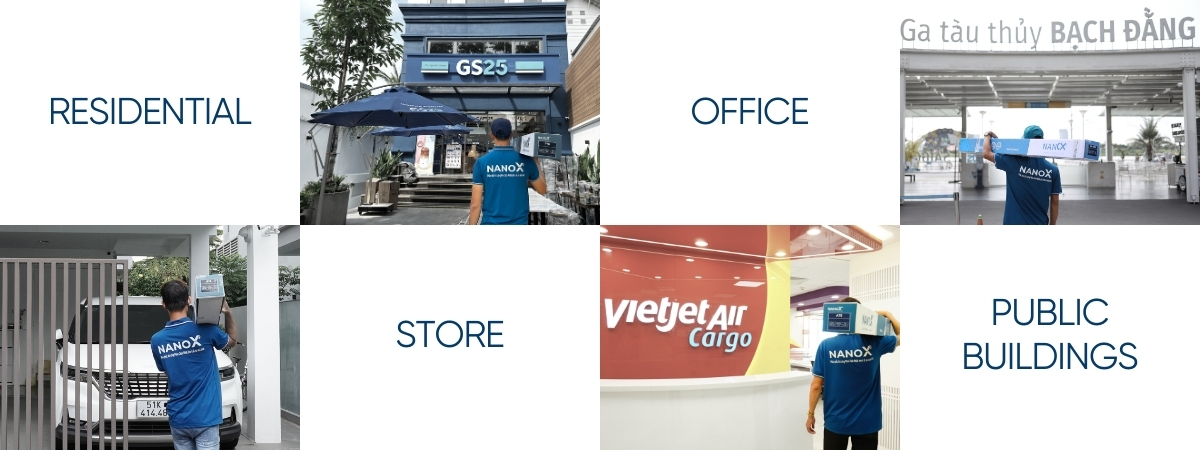
Achievements of NanoX in Vietnam
NanoFilm’s extensive experience of over 12 years in the industry has served as a solid foundation for the strong and steady development of NanoX in the Vietnamese market. Currently, NanoX has built a network of more than 80 dealerships nationwide, alongside numerous satisfied customers who highly appreciate the quality of products and services.
Prominent large-scale projects of NanoX include: McDonald’s Vietnam chain, Diag Clinic chain, Guardian store chain, Diamond Fitness Center chain, BIDV Bank offices, Vietjet Air offices…
Outstanding Features of NanoX Architectural Heat Insulation Film
NanoX heat insulation films for architectural glass possess 7 outstanding features:

High-performance heat blocking up to 90%
Total Solar Energy Rejected (TSER) rate reaches up to over 90%. NanoX architectural insulation films strongly block heat by absorbing solar heat passing through the glass surface and releasing it back to the external environment.
This capability is achieved thanks to NanoX’s exclusive Nano Ceramic X-Shield technology, creating an ideal barrier that effectively minimizes solar heat penetration, maintaining a stable indoor temperature and providing a comfortably cool living space.
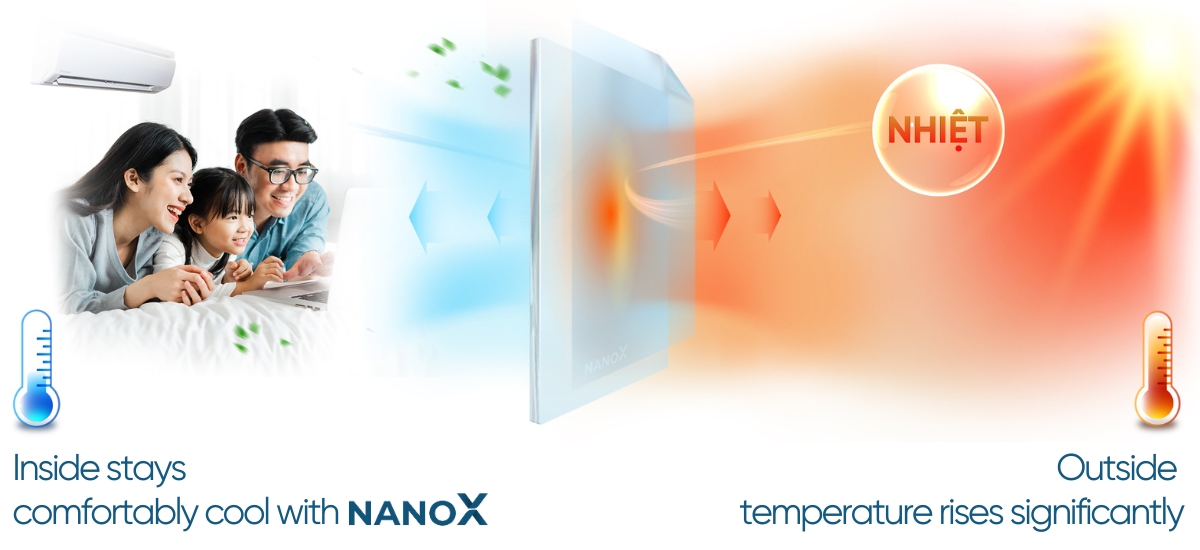
Blocks Infrared Rays up to 100%
Infrared rejection (IRR) capability reaches an absolute rate of 100%. NanoX heat insulation films do not block heat by conventional methods such as darkening, which reduces the amount of visible light passing through windows, glass partitions, or glass ceilings…
Instead, NanoX architectural film blocks heat by completely filtering out infrared rays, the primary heat-carrying component in sunlight. Thanks to this technology, NanoX offers transparent window insulation films that still provide excellent heat-blocking performance.
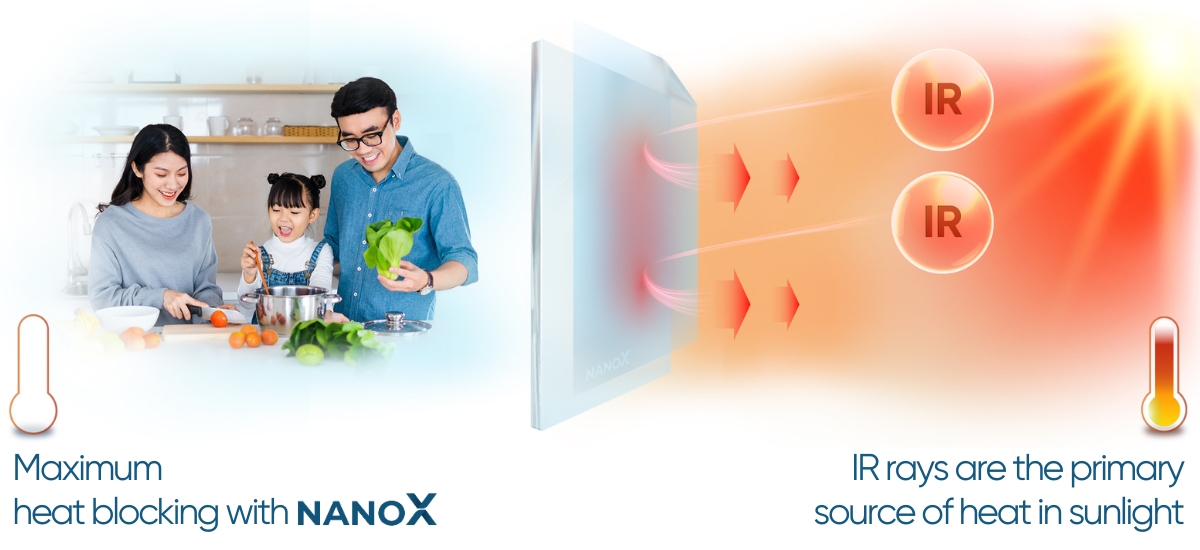
Blocks UV Rays up to 100%
Ultraviolet rejection (UVR) capability reaches up to 100%, including both UVB and UVA rays. Besides heat-blocking, NanoX architectural insulation films also emphasize comprehensive health protection for users. All NanoX films can block 99% of UV rays.
In particular, NanoX has developed the UV400 Skincare insulation film line featuring an advanced broad-spectrum UV filtering system. This specialized film can block 100% of UV rays, including UVB & UVA up to 400 nm wavelength, as well as blue light in the wavelength range of 400 – 420 nm.
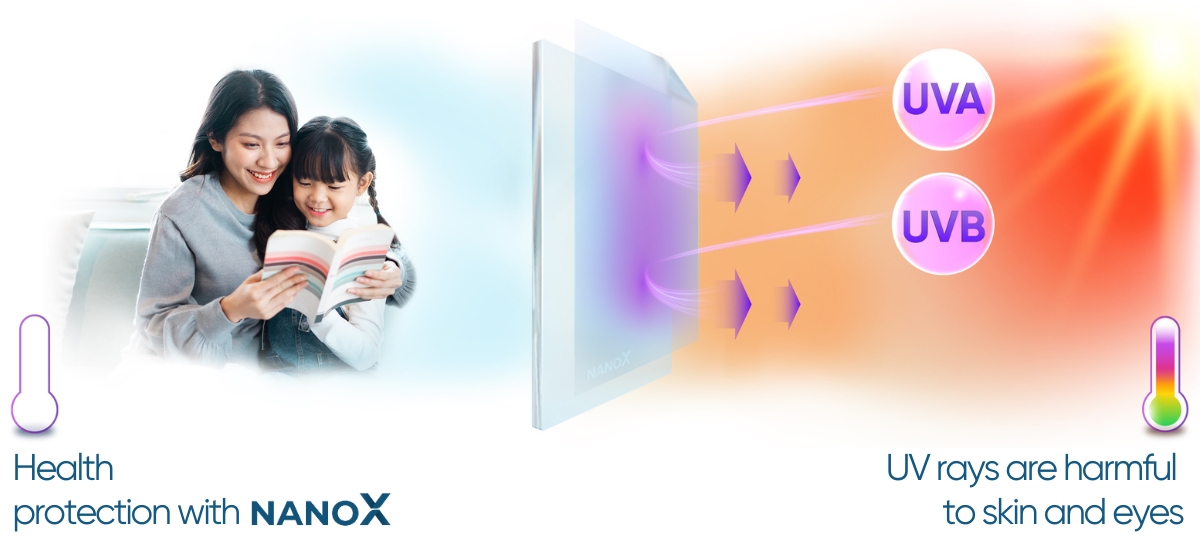
High Transparency
Transparency is one of the distinguishing features of NanoX window and glass insulation films compared to the general market. It is challenging to simultaneously optimize both heat rejection and transparency. However, NanoX films can accurately transmit light passing through without causing scattering.
NanoX window insulation films consistently achieve very high transparency levels. Most impressively, the Diamond View series reaches transparency levels exceeding 99%. This architectural film line hardly alters visibility through the glass, providing clear, natural, and realistic views.
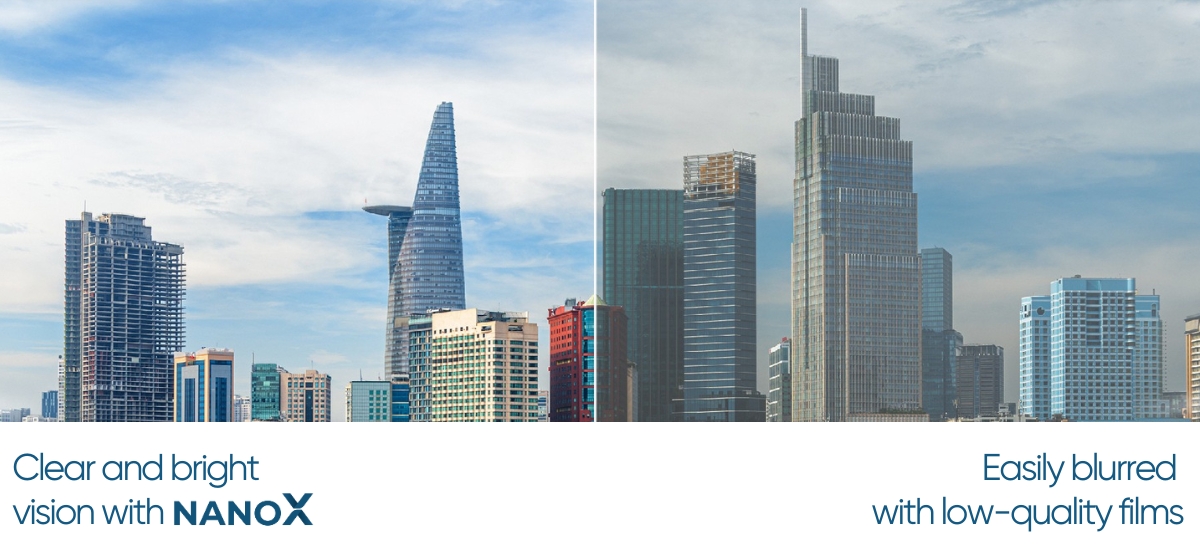
Glare Reduction
Heat insulation always goes hand in hand with glare control. That’s why NanoX residential window insulation films also feature anti-glare capabilities. The film can regulate and reduce the intensity of sunlight passing through the glass at various adjustable levels.
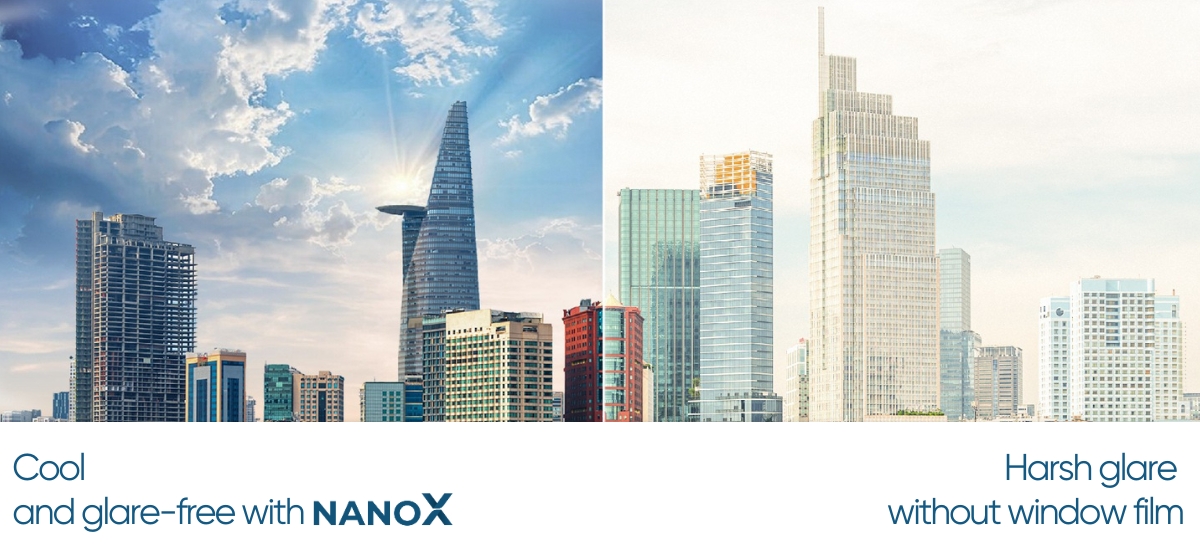
Privacy Protection
Applying NanoX window insulation film helps limit visibility from the outside while maintaining a clear view from the inside. This effect is achieved by utilizing the difference in light intensity between the outdoor and indoor environments. This feature enhances privacy and strengthens security for your living space.
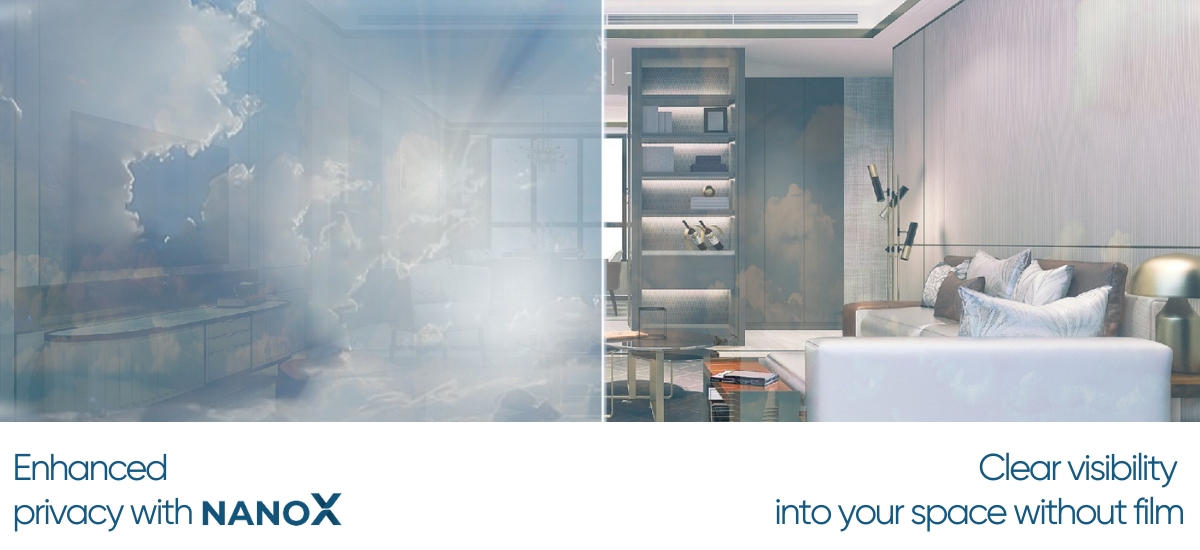
Clear visibility into your space without film
Your paragraph is already clear and well-written! Here’s a slightly refined version for an even smoother, more natural flow, especially for marketing or presentation purposes: Applying NanoX window insulation film reduces visibility from the outside while keeping your indoor view crystal clear. This effect is made possible by leveraging the difference in light intensity between outdoor and indoor environments. As a result, NanoX films enhance privacy and boost security – creating a more comfortable and protected living space. Let me know if you want it to sound more technical, more casual, or tailored for a brochure, website, or voice-over!
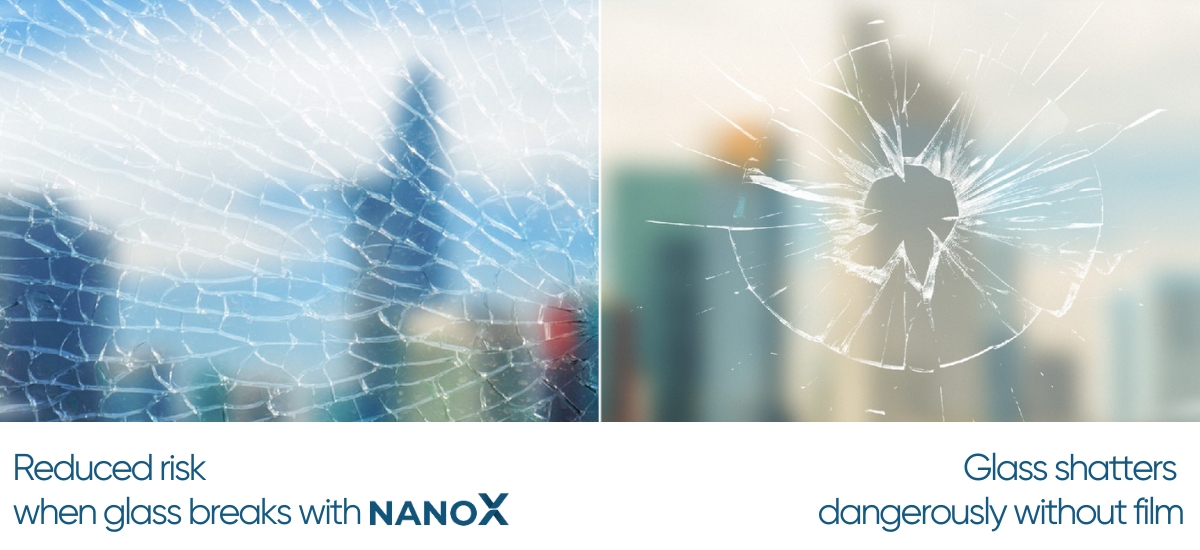
NanoX Architectural Window Film Production Technology
NanoX architectural insulation films are manufactured using Nano Ceramic X-Shield technology. This proprietary technology was developed by NanoX in collaboration with a team of experts from South Korea, tailored specifically to suit Vietnam’s climate conditions.
Nano Ceramic X-Shield uses advanced engineered ceramic—an inorganic material—as the primary component in film production. This material offers several key advantages: exceptional heat insulation, high durability, user health safety, environmental friendliness, and no interference with electronic signals.

Notably, the ceramic particles are fired using advanced techniques, achieving high purity and an ultra-fine size of just 28 nm (compared to the typical 50–100 nm). This results in ultra-dense bonding structures, significantly enhancing both the durability and heat insulation performance of the film.
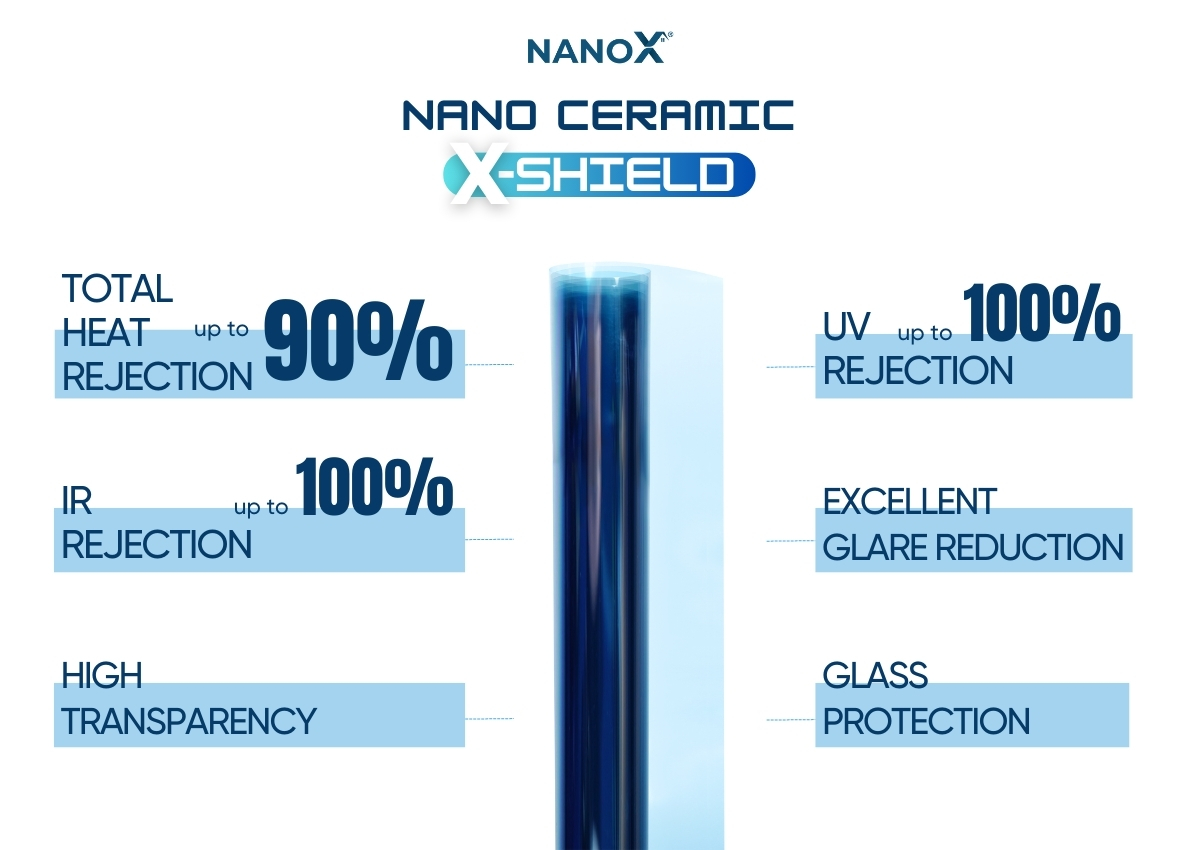
5 Reasons to Choose NanoX Architectural Window Insulation Film
High-Performance Heat Insulation
NanoX is committed to delivering genuine insulation performance and authentic quality at the most competitive, transparent pricing.
Proven Results
NanoX is always ready to demonstrate product effectiveness, allowing customers to experience the actual heat rejection performance before making a purchase.
Professional Installation
Ensures smooth, flat, and seamless film surfaces after installation.
Guarantees aesthetics—no peeling, cracking, or bubbling.
All film edges are precisely trimmed 1–2 mm inside the window frame.
No film splicing if both sides of the glass are ≤ 1,500 mm.
Films are applied on the interior side of windows as specified by the customer.
Long-Term Warranty
Warranty coverage ranges from 3 to 15 years depending on the film type.
During the warranty period, if there is any issue caused by manufacturing defects or installation errors, NanoX will take full responsibility and resolve it within 48 hours of receiving a notice from the customer.
Customer-Centric Service
Personalized consultation based on actual needs
Free on-site consultation and inspection (regardless of order value)
In-home sample film application for real-life experience before purchasing
Friendly, dedicated support—available 24/7
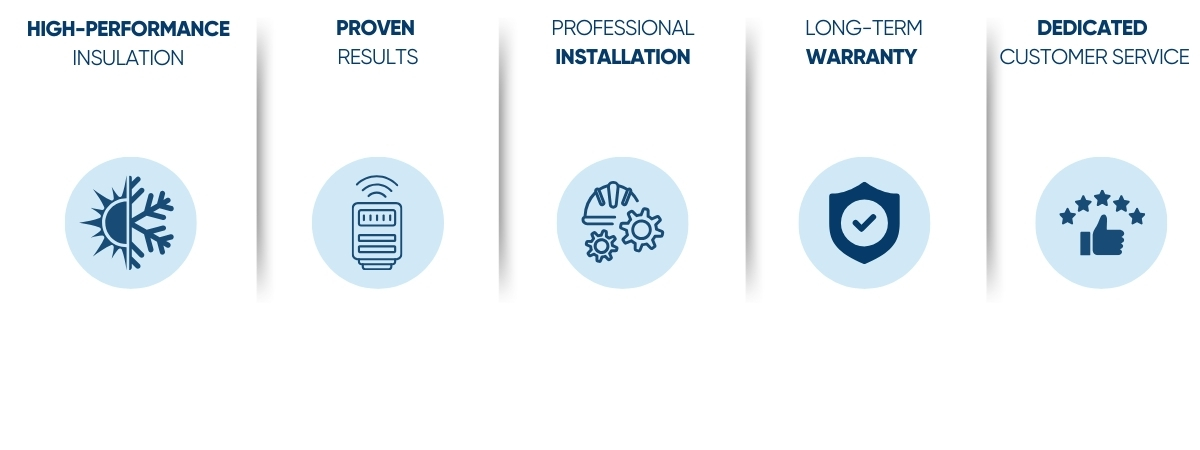
NanoX Architectural Window Film Installation Process
NanoX follows a standardized installation process with a focus on Professionalism – Efficiency – Speed:
Step 1: Consultation, On-site Survey & Installation Plan Proposal
Step 2: Film Code Selection
Step 3: Film Installation
Step 4: Final Inspection & Handover
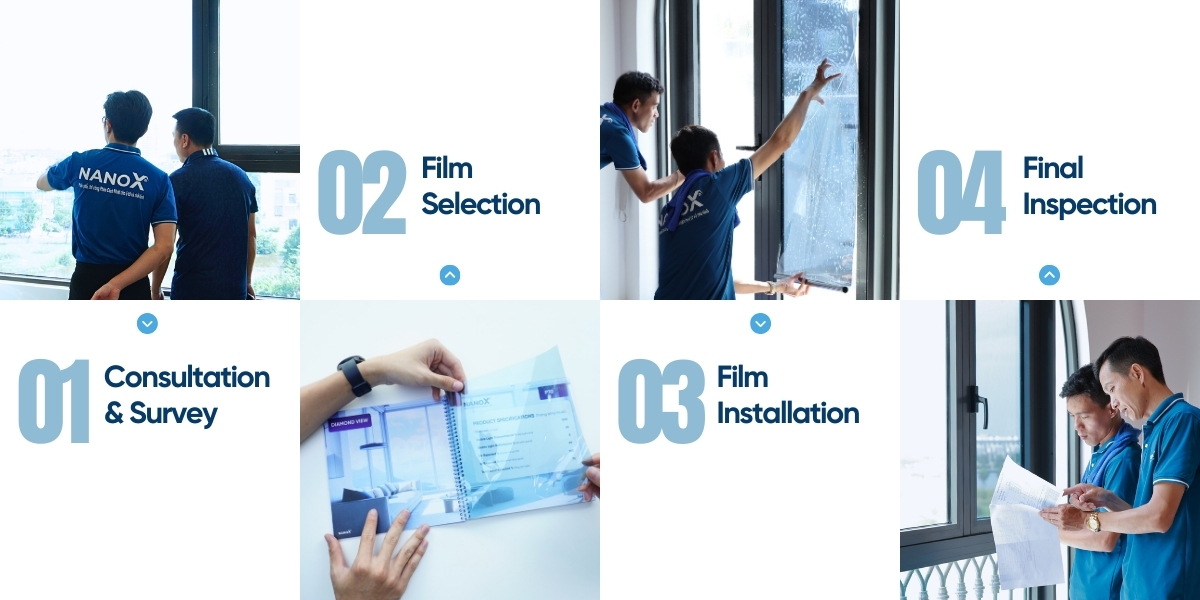
Real-Life Images of Window Film Installation at NanoX
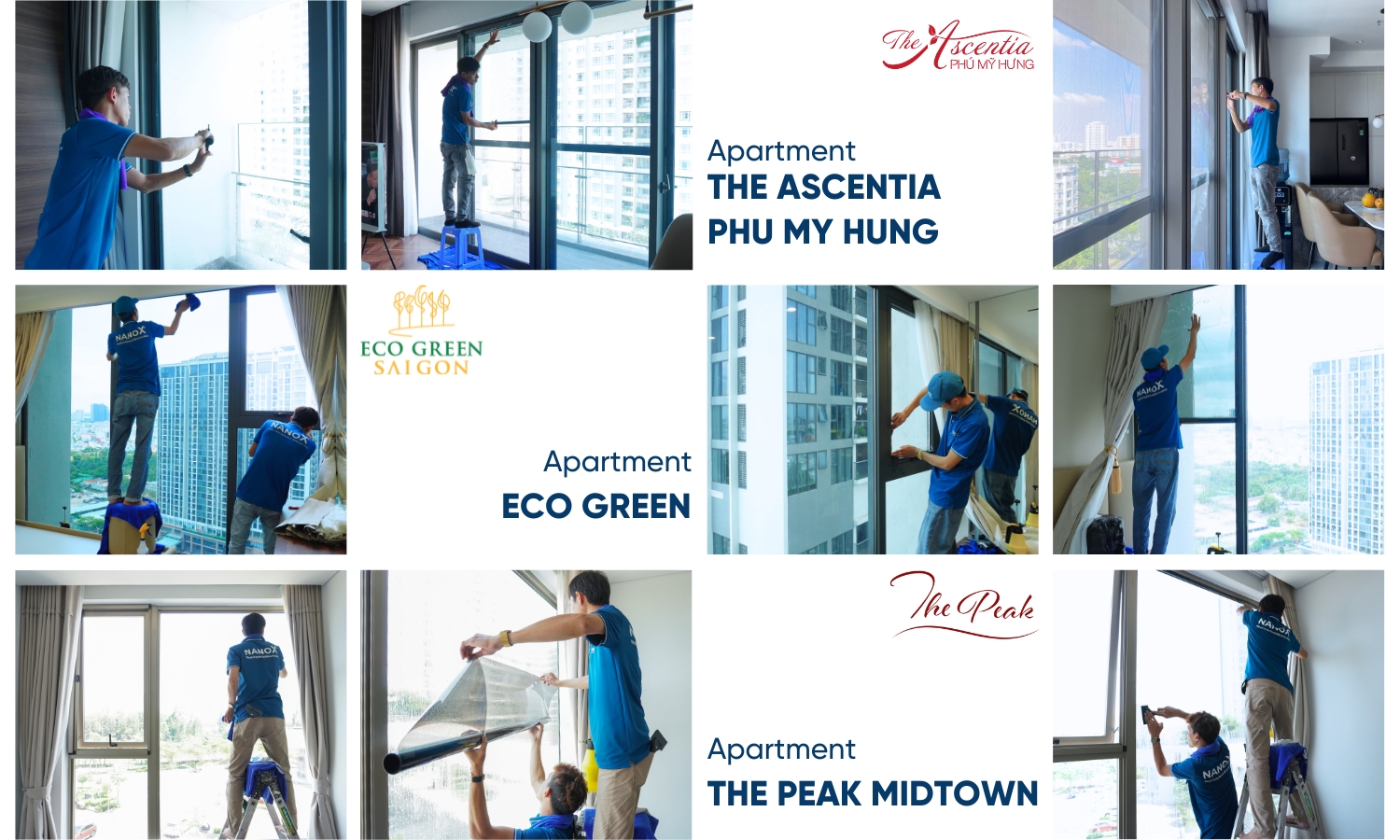



Frequently Asked Questions About Architectural Window Insulation Film
How much does window insulation film cost?
The price of architectural window insulation film ranges from a few hundred thousand to several million VND per square meter. The cost depends on various factors such as brand, technology, type of film, and the total square meters to be installed.
Is a window heat-insulating sticker the same as insulation film?
Yes, they are the same. Since the term “window insulation film” is still relatively new, it goes by various names such as: heat-reducing window film, sun-blocking window sticker, window sun protection film, heat-insulating film sheet, or anti-heat decal.
How many degrees can window insulation film reduce?
Window insulation films can reduce the indoor temperature by about 3–10°C compared to untreated glass. This difference can be measured using a thermometer or specialized measuring devices.
Is window insulation film really effective?
Yes, it is. High-quality window insulation films have proven heat rejection capabilities. The effectiveness can be measured with specialized tools.
How long is the warranty for window insulation film?
Reputable brands on the market typically offer long-term warranties. For example, NanoX window insulation film has a warranty period ranging from 3 to 15 years, depending on the product line.
6. Should window insulation film be applied inside or outside?
For residential buildings, insulation film is applied on the inside of the glass surface. This ensures maximum heat rejection performance and minimizes environmental effects that could reduce the film’s lifespan.

NanoX Genuine Window Insulation Film from Vietnam
- Hotline: 0777.888.797
- Website: https://nanoX.vn/
- Email: contact@nanoX.vn
- Showroom: No. 2, Road 34, Van Phuc Urban Area, Hiep Binh Phuoc, Thu Duc, Ho Chi Minh City
